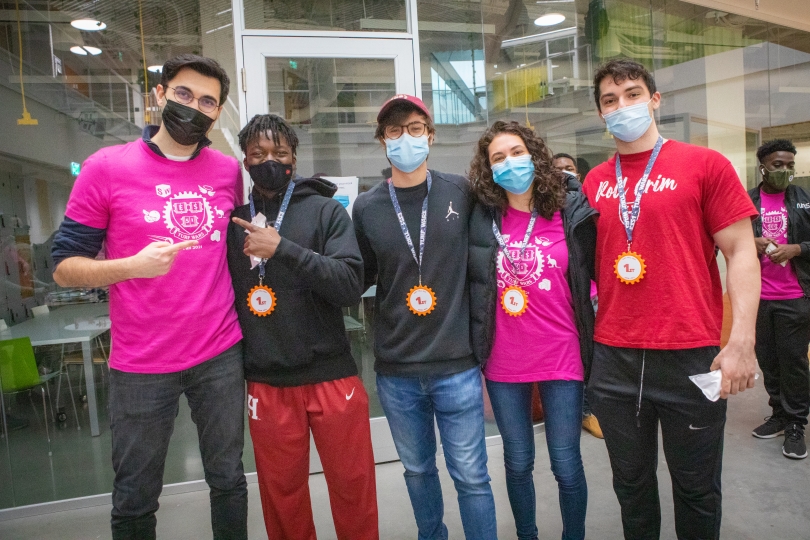News
Harvard hockey teams have their annual Beanpot Tournament, where they’ll try to outscore the other top college programs in the Boston area.
When mechanical engineering students at the Harvard John A. Paulson School of Engineering (SEAS) want to put pucks in a net, they build robots.
Four students from SEAS showed exactly what solid design and great execution can produce when their team dominated Turf Wars, the end-of-semester robotics competition for “ES51: Computer Aided Design,” on Dec. 8 at the Science and Engineering Complex in Allston.
“We knew that our robot was very solid and had potential,” said Bernard Zoungrana, ‘24, who drove his Caglar’s Angels team’s robot to four consecutive wins, including a 20-2 victory in the championship. “Everyone had a good robot, and it was just a matter of being able to move it around the field.”
Tomasso Serafin (‘24), Emma Zuckerman (‘24) and Cyrus Asgari (‘24) completed the winning quartet.
Bernard Zoungrana ('24), center, drives his robot during the finals of the Turf Wars robotics competition at the Science and Engineering Complex in Allston. (Credit: Eliza Grinnell/SEAS)
In this semester’s Turf Wars, six robots competed in four-minute, two-on-two matches. Drivers used remote controls to maneuver their robot down a ramp and into the center area, where hockey pucks were scattered along an artificial turf. The robots had to collect the pucks, drive back up a ramp on the opposite side of the turf, and deposit the pucks in a goal to score points.
Caglar’s Angels’ winning design included a drivetrain that enabled four-wheel drive, allowing the robot, dubbed “Daddy Cloud,” to easily move backwards or forwards up the ramps, as well as spin 360 degrees in place. The team designed an L-shaped black scoop that could lift a puck using a 90-degree servomotor, and tilt back to slide the puck into a red storage area. Then, the driver just had to drive Daddy Cloud up a ramp, spin it so the storage area faced the goal, and trigger another servo to drop the puck into the net.
The key to the winning team’s success was speed and consistency. They scored 76 points across four matches, surpassing the combined point total of every other team in the competition.
“They were the ones who finished their drivetrain first, so that gave them some time to work on and practice their robot-driving skills,” said Caglar Ozturk, Lecturer on Engineering Science. “Their success comes from their time management. They finished earlier, so they could focus on optimizing the mechanisms.”
Zoungrana drove so well, his team never had to use any of their five “lives,” which other teams used to make mid-match repairs when their robots flipped over, got stuck, or broke.
“It was a better idea to have one person constantly testing (the driving), first of all to give us a level playing field during testing so we didn’t have the variable of who was driving, but also to get more practice in,” Serafin said. “Obviously it showed.”
Caglar Ozturk, Lecturer on Engineering Science poses with Caglar's Angels, the winning team in the Turf Wars robotics competition at the Science and Engineering Complex in Allston. From left is Ozturk, Bernard Zoungrana (‘24), Tomasso Serafin (‘24), Emma Zuckerman (‘24) and Cyrus Asgari ('24). (Credit: Eliza Grinnell/SEAS)
Caglar’s Solid Workers (CSW), with Joey Liu (‘24), Ben Schroeder (‘24), Mike Binkowski (‘24) and Trevor Schultz (‘24), finished second.
The Crimson Kangaroos, composed of Roaa Marei (‘25), Noah Miles (‘24) and Lana Wagner (‘25), took third place, and also won the award for Best Computer Aided Design (CAD). Orange Juice, composed of Rohan Jakhete (‘24), Alex Bell (‘25) and Sofia Castore (‘24), won Best Video, which each team created to introduce the members and explain their design process.
Grabbing hockey pucks with robots is a fun way to end a semester. The loud music, commemorative pink T-shirts and occasional dance breaks reflected the energetic atmosphere on the final day.
But for all the laughs throughout the morning, Turf Wars was still a test of how well Ozturk’s students had mastered the skills taught throughout the semester and utilized them while constructing their robots in the Active Learning Labs.
“At the beginning, we teach them how to do all of this in the software,” Ozturk said. “Once you have anything perfectly assembled in the CAD design, then it’s easy to go in, do the manufacturing and do the real assembly."
“This was my first mechanical engineering class, so I was just trying to get a feel for what mechanical engineering is like,” Zuckerman said. “It definitely helped me understand what it is, and I did end up declaring in mechanical engineering.”
Topics: Allston Campus, Electrical Engineering, Materials Science & Mechanical Engineering, Robotics
Cutting-edge science delivered direct to your inbox.
Join the Harvard SEAS mailing list.
Press Contact
Matt Goisman | mgoisman@g.harvard.edu




